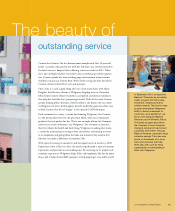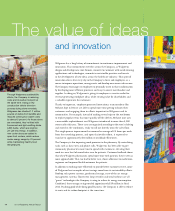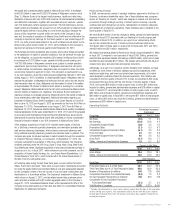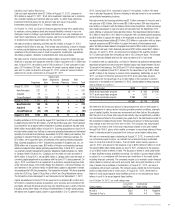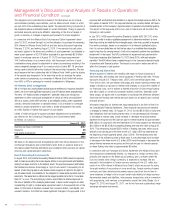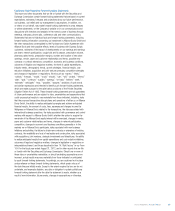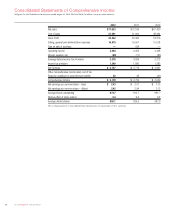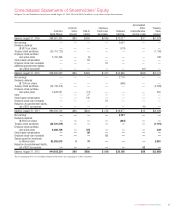Walgreens 2012 Annual Report Download - page 20
Download and view the complete annual report
Please find page 20 of the 2012 Walgreens annual report below. You can navigate through the pages in the report by either clicking on the pages listed below, or by using the keyword search tool below to find specific information within the annual report.
reductions in reimbursements independent of AMP. In addition, we continuously
face reimbursement pressure from pharmacy benefit management (PBM) companies,
health maintenance organizations, managed care organizations and other commercial
third party payers, and our agreements with these payers are regularly subject to
expiration, termination or renegotiation.
Following our June 21, 2011 announcement that contract renewal negotiations
with pharmacy benefit manager Express Scripts, Inc. (Express Scripts) had been
unsuccessful, Walgreens exited the Express Scripts pharmacy provider network as
of January 1, 2012. On July 19, 2012, Walgreens and Express Scripts announced
their entry into a new multiyear agreement pursuant to which Walgreens began
participating in the broadest Express Scripts retail pharmacy provider network
available to Express Scripts clients as of September 15, 2012. From January 1,
2012, until September 14, 2012, however, Express Scripts’ network did not include
Walgreens pharmacies. Express Scripts, in its capacity as a pharmacy benefits
manager, processed approximately 88 million prescriptions filled by Walgreens in
fiscal 2011, representing approximately $5.3 billion of our fiscal 2011 net sales.
Compared to fiscal 2011, we estimate that the negative impact of not being part
of the Express Scripts, Inc. pharmacy provider network, net of associated cost
reductions, was $0.21 per diluted share.
We expect the positive impact of our new agreement with Express Scripts will be
incremental over time, particularly over the first several quarters after September 15,
2012. While we cannot predict with certainty which Express Scripts clients will
choose to include us in their pharmacy networks after September 15, 2012,
we expect that our pharmacies will participate in the pharmacy networks of most
clients for which Express Scripts serves as pharmacy benefit manager. However,
one substantial client of Express Scripts, the United States Department of Defense
TRICARE program, has announced that Walgreens will continue to not be a part of
its pharmacy network and will be designated as a non-network pharmacy provider
for TRICARE beneficiaries. Most of the patients we served in calendar 2011 who
participated in a plan for which Express Scripts served as pharmacy benefit manager
transitioned to another pharmacy after we exited the Express Scripts network on
January 1, 2012. We expect to incur marketing and other costs in connection with
efforts to regain former patients and attract new patients covered by plans for
which we become a network pharmacy provider as a result of our agreement
with Express Scripts.
Ultimately, the magnitude and timing of the impact on our financial results of
rejoining the Express Scripts retail pharmacy provider network will depend on our
ability to regain former patients and attract new patients covered by existing and
new Express Scripts clients; however, we cannot predict with certainty what level
of business we will achieve as a result of rejoining the Express Scripts retail
pharmacy provider network in any particular future time period. We also intend to
continue to pursue initiatives seeking to align our costs with anticipated business
levels and requirements over time. Rejoining the Express Scripts retail pharmacy
provider network is expected to positively affect our net sales, net earnings and
cash flows over time relative to the levels we would otherwise achieve if we were
not in the Express Scripts network and to mitigate the adverse effects related
to our non-participation in the Express Scripts retail pharmacy provider network
during the period from January 1, 2012 through September 14, 2012.
See “Cautionary Note Regarding Forward-Looking Statements.”
Total front-end sales have grown due to sales gains in existing stores, acquired
stores and new store openings. Front-end sales have increased in the
non-prescription drugs, beer and wine, beauty, convenience and fresh foods
and photofinishing categories.
Periodically, we make strategic acquisitions and investments that fit our long-term
growth objectives. Consideration is given to retail, health and wellbeing enterprises
and other potential acquisitions and investments that provide unique opportunities
and fit our business objectives. On August 2, 2012, we completed the initial investment
contemplated by the Purchase and Option Agreement dated June 18, 2012, by and
among Walgreens, Alliance Boots GmbH and AB Acquisitions Holdings Limited (the
“Purchase and Option Agreement”), which resulted in our acquisition of 45% of
The following discussion and analysis of our financial condition and results of
operations should be read together with the financial statements and the related
notes included elsewhere herein. This discussion contains forward-looking
statements that involve risks and uncertainties. Our actual results may differ
materially from those discussed in forward-looking statements. Factors that
might cause a difference include, but are not limited to, those discussed
under “Cautionary Note Regarding Forward-Looking Statements” below and in
Item 1A (Risk Factors) in our Annual Report on Form 10-K. References herein
to “Walgreens,” the “Company,” “we,” “us” or “our” refer to Walgreen Co. and
its subsidiaries included in the consolidated financial statements and does not
include unconsolidated partially owned entities, such as Alliance Boots GmbH,
of which we own 45% of the outstanding share capital, except as otherwise
indicated or the context otherwise requires.
Introduction
Walgreens is principally a retail drugstore chain that sells prescription and non-
prescription drugs and general merchandise. General merchandise includes, among
other things, household items, convenience and fresh foods, personal care, beauty
care, photofinishing and candy. Customers can have prescriptions filled in retail
pharmacies as well as through the mail, and customers may also place orders by
telephone and online. At August 31, 2012, we operated 8,385 locations in 50 states,
the District of Columbia, Guam and Puerto Rico. Total locations do not include
360 Take Care Clinics that are operated primarily within other Walgreens locations
or locations of unconsolidated partially owned entities such as Alliance Boots GmbH.
Number of Locations
Location Type 2012 2011 2010
Drugstores 7,930 7,761 7,562
Worksite Health and Wellness Centers 366 355 367
Infusion and Respiratory Services Facilities 76 83 101
Specialty Pharmacies 11 9 14
Mail Service Facilities 2 2 2
Total 8,385 8,210 8,046
The drugstore industry is highly competitive. In addition to other drugstore chains,
independent drugstores and mail order prescription providers, we compete with
various other retailers including grocery stores, convenience stores, mass merchants,
online pharmacies, warehouse clubs and dollar stores.
Our sales, gross profit margin and gross profit dollars are impacted by, among
other things, both the percentage of prescriptions that we fill that are generic
and the rate at which new generic drugs are introduced to the market. In general,
generic versions of drugs generate lower total sales dollars per prescription, but
higher gross profit margins and gross profit dollars, as compared with patent-
protected brand name drugs. The positive impact on gross profit margins and
gross profit dollars typically has been significant in the first several months after
a generic version of a drug is first allowed to compete with the branded version,
which is generally referred to as a “generic conversion.” In any given year, the
number of major brand name drugs that undergo a conversion from branded to
generic status can increase or decrease, which can have a significant impact on
our sales, gross profit margins and gross profit dollars. And, because any number
of factors outside of our control or ability to foresee can affect timing for a generic
conversion, we face substantial uncertainty in predicting when such conversions
will occur and what effect they will have on particular future periods.
The long-term outlook for prescription utilization is strong due in part to the aging
population, the increasing utilization of generic drugs, the continued development
of innovative drugs that improve quality of life and control healthcare costs, and
the expansion of healthcare insurance coverage under the Patient Protection
and Affordable Care Act signed into law in 2010 (the ACA). The ACA seeks to
reduce federal spending by altering the Medicaid reimbursement formula (AMP)
for multi-source drugs, and, when implemented, is expected to reduce Medicaid
reimbursements. State Medicaid programs are also expected to continue to seek
Management’s Discussion and Analysis of Results of Operations
and Financial Condition
18 2012 Walgreens Annual Report







